If you have the slightest interest in one of the cutest creatures on this planet, I urge you to read this article (or at least look at the pictures!). The red panda has some unique adaptations as one of the world’s only vegetarian carnivores!
Red pandas are unique carnivores that eat mainly bamboo shoots and leaves. They eat 2 to 4 pounds (1 – 2 kg) or nearly 20,000 bamboo leaves every day. They may also eat fruit, acorns, eggs, small birds, and small rodents.
One of the red panda’s unique adaptations to the bamboo eating lifestyle is a unique pseudothumb or false panda’s thumb. After thousands of years of selection pressure, a specialized wrist bone has become enlarged and elongated, providing red pandas with the ability to grip and handle bamboo with remarkable dexterity.
Red pandas are considered endangered, with roughly 10,000 individuals living in the wild, although some estimates suggest as few as 2,500.
Red Pandas Are One of Few Bamboo Eating Mammals
The red panda is a carnivore that has adapted to a highly specialized diet of bamboo leaves. They use their strong chewing muscles and powerful molars to chew tough bamboo leaves and shoots. Unlike other carnivores, the molars have elaborate crown patterns modified for chewing bamboo.
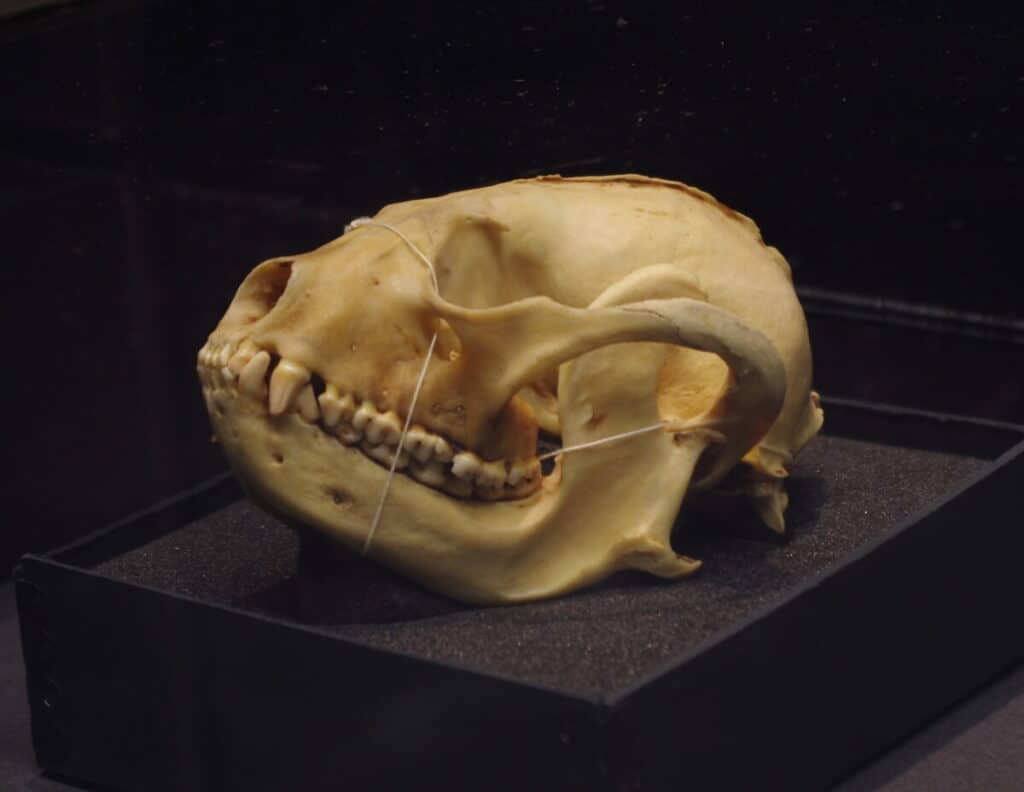
Since bamboo is such a low energy food source, red pandas spend 10-12 hours a day, or nearly all their waking hours, foraging for bamboo. They need to eat a lot of bamboo – roughly 20-30 percent of their body weight each day—or about 2 to 4 pounds (1 to 2 kilograms) of bamboo shoots and leaves. Based on the best research I can find, this amounts to roughly 20,000 bamboo leaves every single day (Reid et al. 1991).
Even though they specialize in feeding on bamboo, red pandas have the digestive system of a carnivore with a short gut that lacks the bacteria needed to properly digest fibrous plant material. Most herbivores have a long gut to give microbes adequate time and space to digest nutrient-poor plant material. Because of the short gut, food passes through the red panda quickly, taking only 2 – 4 hours, and they only digest about 25 percent of their daily bamboo intake.
Based on this info, we can surmise that where there are red pandas there must be a steady supply of fresh panda poo! Probably a good supply of fertilizer for the next generation of bamboo! In this way, we can think of them as ecosystem engineers creating their own habitat and contributing to the growth of their primary food source.
Why do Red Pandas Specialize in Eating Bamboo?
A nutritionally poor plant like bamboo does not seem to be a great choice for 90 percent of any animal’s diet. However, there’s more to bamboo than meets the eye – it is extremely abundant, it grows quickly, and there’s not much competition for such a poor food source. You don’t see many mammals fighting one another to get their share of bamboo!
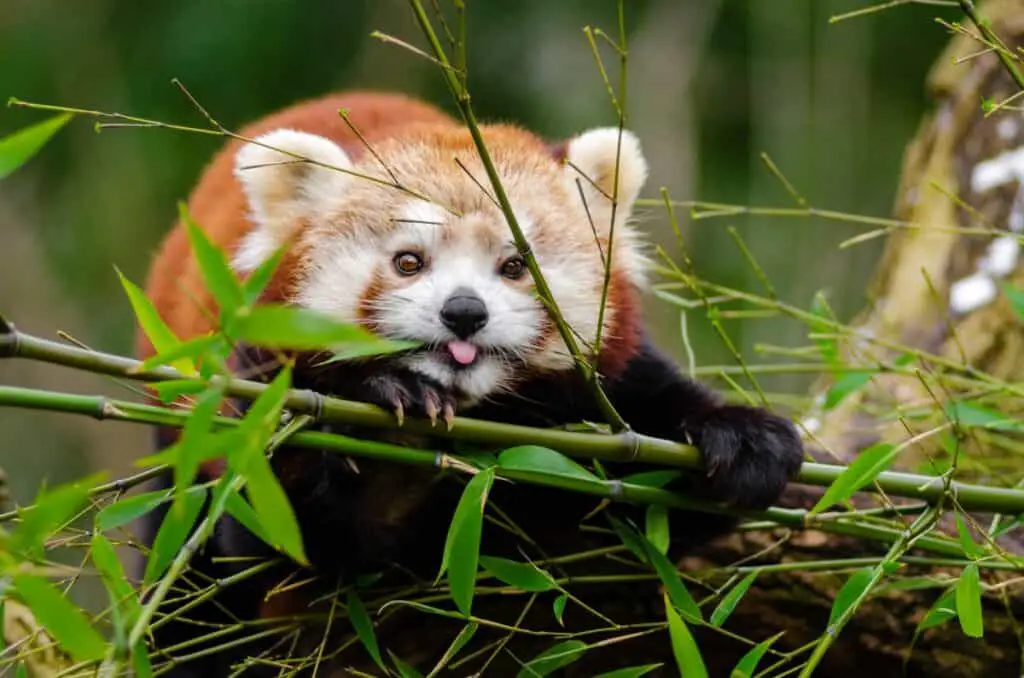
Only a few mammal species depend on bamboo for their diet and they are spread far and wide: notably red pandas, giant pandas, bamboo lemurs from Madagascar, and bamboo rats from China and Southeast Asia.
Bamboo leaves provide a low-nutrition, high-fiber food with 13.2% protein, 3.4% fat, and 3.3% soluble carbohydrate.
Surprisingly, bamboo can still provide the basis for a high protein diet, especially when bamboo shoots are available.
Bamboo shoots are much more valued for nutrition than the leaves. Nutritional analysis of bamboo shoots indicates a higher content of protein, amino acids, minerals, fibre, and carbohydrates.
Of the 40 or so species of bamboo available to them, red pandas eat only 1 or 2 of the most nutritious species.
High Mountain Habitat
Red pandas live in southeast Asia, in the Himalayan Mountains, Nepal, India, Bhutan, China, and Myanmar. They inhabit temperate and sub-tropical forests with mixed deciduous-coniferous tree species, particularly in areas with dense bamboo undergrowth.
They typically live at higher altitudes from 5,000 to 16,000 feet (1500 – 4800 m) above sea level. They are well-adapted to living in the cold with furry paws and thick fur coats. In cold temperatures, they tend to sleep in a tightly curled position to conserve heat loss, using their big bushy tails as comforters.
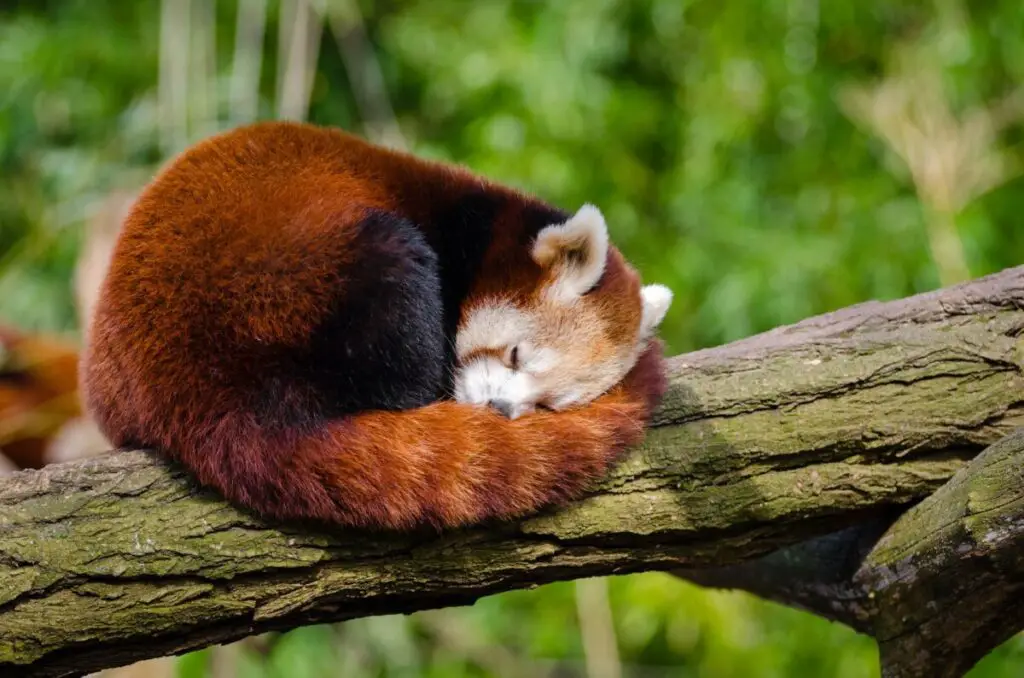
Red pandas like to be near a dependable water source. In one study, red pandas were never detected farther than 70m from a water source. In Jigme Dorji National Park, 70% of red panda droppings were encountered within 100m of a water source.
Watch red pandas frolic in the snow
Can Red Pandas Reduce Their Metabolic Rate?
It is thought that red pandas can reduce their metabolic rate without decreasing core body temperature, thereby saving energy (McNab 1988). However, there’s still uncertainty about how red pandas deal with extreme cold. Some articles indicate that the animals can enter torpor with decreased physiological activity, but I haven’t found any studies to support that conclusion.
Recent studies (Fei et al. 2017) of both sexes during winter and summer concluded that “Contrary to our expectations based on their low-quality bamboo diet, the metabolic rates of red pandas were similar to mammals of the same size.”

Additional research (Zhang et al. 2011) shows that red pandas have a lower circadian activity rate in the winter and a higher frequency of long rests, which is probably an adaptation to cold through heat loss reduction.
Interested in another animal that has adapted to a nutritionally poor diet by shrinking its brain? See my article on Koala Brains – Is the Koala the Dumbest Mammal? Why Being Dumb Can Be Smart
Speaking of metabolic rate, see my article about the fascinating creatures that hibernate, including animals that literally freeze solid and live to see another spring!
The Mysterious Panda’s Thumb
Red pandas have an amazing ability to grasp and feed on bamboo, often holding a skinny stalk in one hand while chomping on the leaves. They have evolved pseudothumbs or panda’s ‘thumbs’ which are actually abnormally elongated wrist bones.
It is thought that the false thumb of the red panda evolved as an adaptation to climbing and secondarily developed for grasping bamboo. Red pandas are commonly seen at zoos climbing down trees headfirst, an activity that would be made easier with the enhanced grip provided by the false thumb.

Anatomically, the panda’s “thumb” is not at all like any other digit. It originated from a small bone within the wrist, the radial sesamoid, that now equals the length of the bones in the panda’s true fingers. This pseudothumb underlies a pad on the panda’s forepaw while the five fingers form the base of another pad. A shallow groove separates the two pads and serves as a gripper for bamboo stalks.
Retractable Claws and Hairy Paws
Red pandas have some additional adaptations worth noting.
They have semi-retractable claws used for climbing, a feature that likely allows the animals to keep their claws sharp enough to climb tough, smooth bamboo stalks.
The paw pads are covered with fur so thick that their footprints look like more like a smudge. The fur is thought to be an adaption for walking in the snow and climbing icy, snow covered branches.
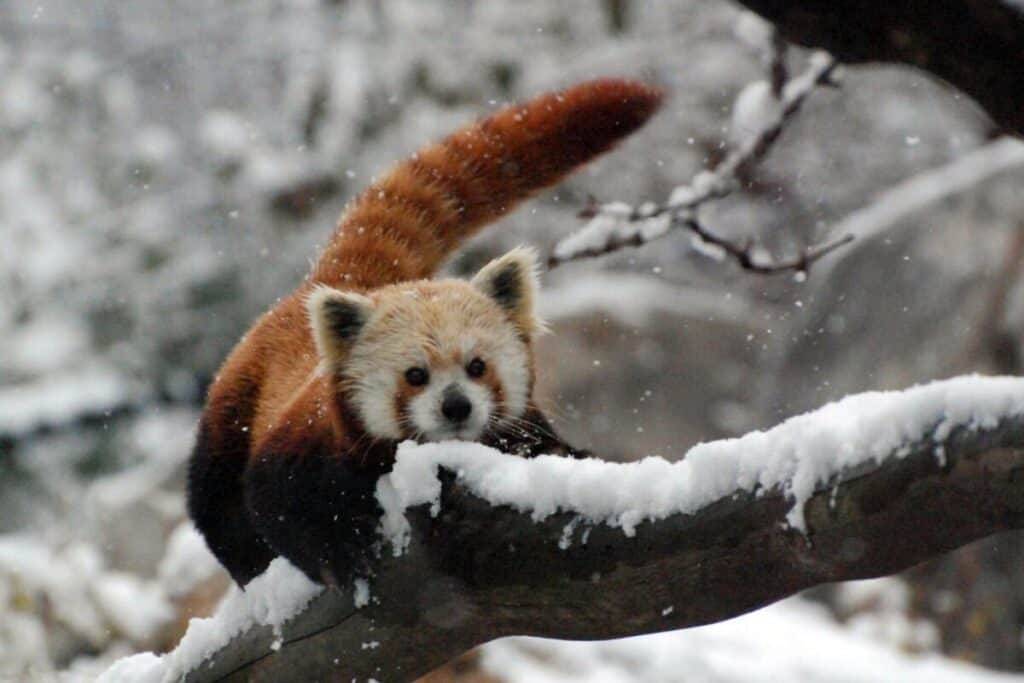
Red Pandas Use Scent Markings
Red pandas mark their territories with scent marking, including urine, feces, and anal gland secretions rubbed onto tree stumps and rocks. Interestingly, small glands within the paw pads secrete what researchers consider to be a colorless, odorless fluid left behind wherever the pandas walk. On a personal note, it might be odorless to humans but likely a different story when it comes to other pandas.
Places that are marked are thoroughly sniffed and licked by other red pandas. They have enlarged papillae on the underside of the tip of the tongue, used to inspect scents.
How do Red Pandas Defend Themselves?
If they feel threatened, red pandas will stand on their hind legs to appear larger, while lunging forward waving their sharp front claws.
Video of red panda practicing defensive moves… on a belligerent rock!
The threat display might be accompanied by a sound described as a quack-snort. These discreet bursts of low frequency sound are used as a threat call, usually with the forepaws raised in threat or defense. They also have a special whistling sound to warn nearby red pandas of a threat.
They won’t hesitate to use their teeth to defend themselves, and being carnivores they have incisors that can inflict some damage.

They might look like charming fellows, but red pandas can release a noxious smelling spray for self defense.
Summary of Red Panda Biology
- Red pandas are predominately solitary and are most active at dawn and dusk.
- Males occupy territories overlapping those of several females, especially in the mating season, and both sexes mark their territories with smelly anal secretions.
- Female usually give birth to twins within a hollow tree nest cavity.
- Young are born blind and helpless, opening their eyes after 18 days.
- They have extremely sharp semi-retractable claws for climbing and when not foraging, pandas are usually found in the trees.
- Red pandas feed on bamboo by grasping the stems with their forepaws and shearing the leaves off with sharp teeth.
- Bamboo is poor in nutrients; to compensate, red pandas are only active for around 56 % of the day.
- Other foods such as roots and fruit as well as small lizards and bird’s eggs are also eaten.
- They are agile in the trees, using their tail for balance although it is not prehensile.
- Red pandas groom themselves thoroughly by licking their paws and fur like a cat. Grooming occurs while in a tree and shortly after awakening or eating, by stretching, licking, and “washing” face with fore and hind paws.
(Adapted from eol.com)
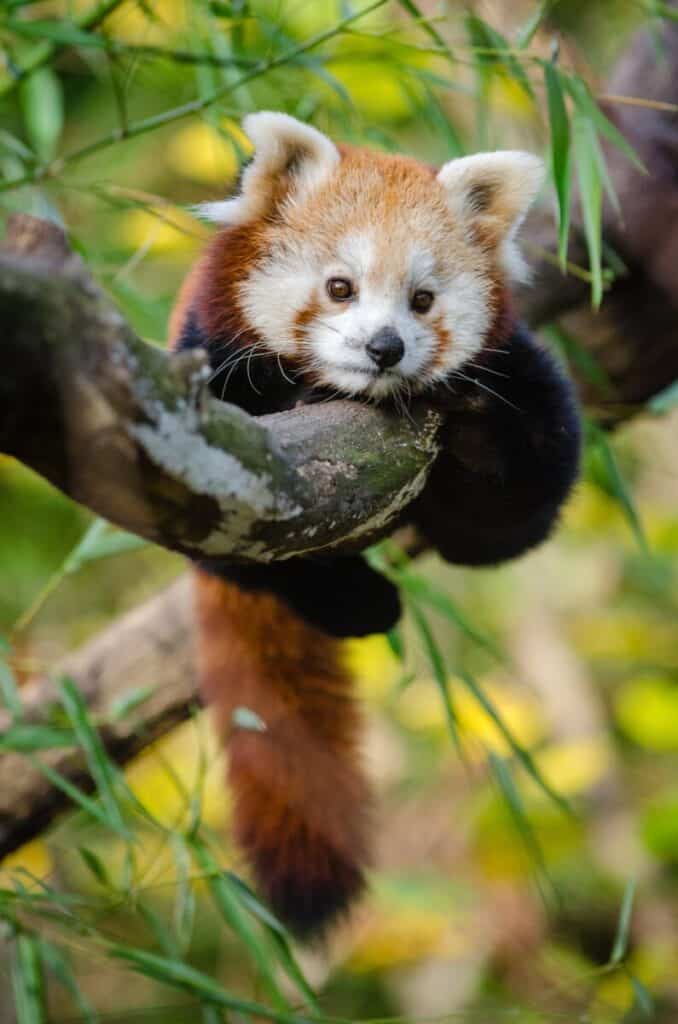
The Gear We Love to Travel With
We love to travel in search of exceptional wildlife viewing opportunities and for life-enhancing cultural experiences.
Here is the gear we love to travel with for recording our adventures in safety and comfort:
- Action Camera: GoPro Hero10 Black – we find these waterproof cameras are invaluable for capturing the essence of our adventures in video format. Still photos are great, but video sequences with all the sights and sounds add an extra dimension. I use short video clips to spice up many of my audiovisual presentations.
- Long Zoom Camera: Panasonic LUMIX FZ300 Long Zoom Digital Camera – I love this camera for its versatility. It goes from wide angle to 28X optical in a relatively compact design. On safari in Africa I’ve managed to get good shots of lions that the folks with long lenses kept missing – because the lions were too close! I also like the 120 fps slow-motion for action shots of birds flying and animals on the move. I call this my “bird camera.”
- 360 Camera: Insta360 ONE R 360 – 5.7K 360 Degree Camera, Stabilization, Waterproof – see my article How to Take Impossible Shots with Your 360 Camera. This camera is literally like taking your own camera crew with you when you travel! Read my article and you’ll see why.
- Backpack camera mount: Peak Design Capture Clip
- Drone: DJI Mini 2 (Fly More Combo) – this mini drone is made for travel!
- Water Filtration: LifeStraw Go Water Filter Bottle
- Binoculars: Vortex Binoculars or Vortex Optics Diamondback HD Binoculars (good price)
Convergent Evolution with Giant Pandas
The red panda’s adaptation to eating bamboo is a case of convergent evolution with the giant panda.
Red pandas and giant pandas are not closely related. The fact that they are both called “panda” probably refers to the fact that both live on a diet of bamboo. The name panda is believed to come from the Nepali word “ponya,” meaning “bamboo eater” or “bamboo footed.”
The giant panda and red panda once had a common ancestor and diverged approximately 43 million years ago (Mya). Both animals belong to the order Carnivora. Giant pandas (Ailuropoda melanoleuca) are distant relatives of the other bears in the family Ursidae. Red pandas (Ailurus fulgens) are more closely related to weasels or raccoons and belong to their own unique family Ailuridae within the superfamily Musteloidea.
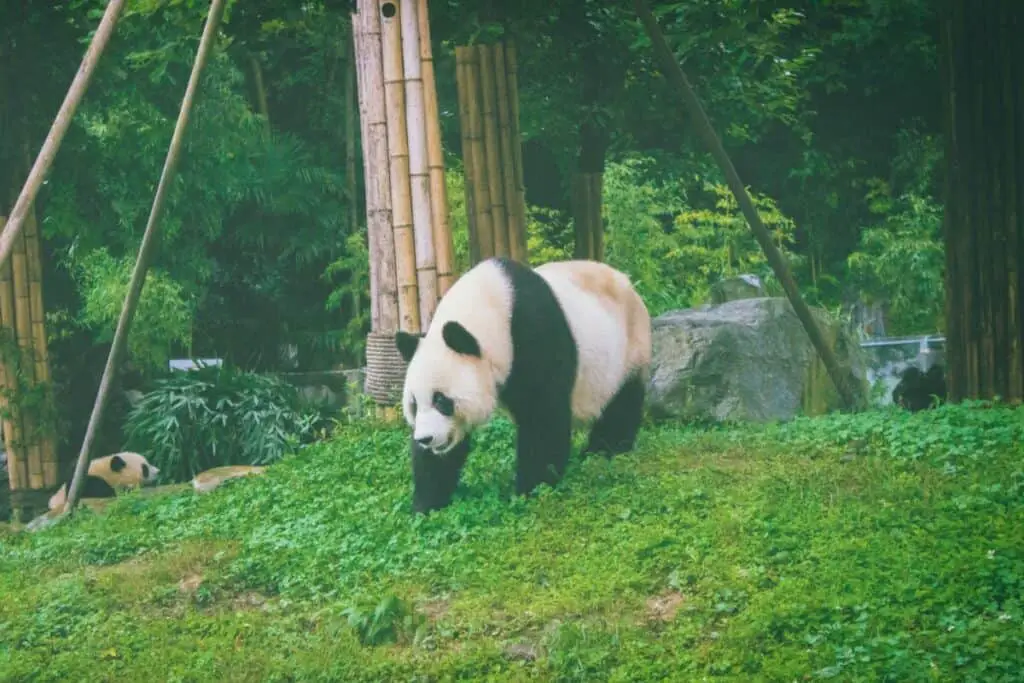
Both are Unique ‘Vegetarian’ Carnivores
As carnivores, both pandas are unique in that they have evolved to become specialized herbivores feeding almost exclusively on a bamboo diet (>90%). Even though both pandas still retain the typical short digestive tract of carnivores, they have specialized adaptations to be able to digest a steady supply of bamboo.
In another a remarkable scenario of genetic convergence, both pandas have lost the umami taste receptor common to most meat-eating animals. The umami taste receptor provides an important taste sense used to perceive components of meat and other protein-rich foods.
Both Have Pseudothumbs
In yet another example of genetic convergence, both red and giant pandas have independently evolved a pseudothumb to help them grasp and feed on bamboo stalks. The false or pseudothumb is referred to by biologists as an elongated or enlarged radial sesamoid bone in case you want to dig deeper.
You might be interested in the Panda principle. also known as the “Principle of Imperfection.” This refers to evolutionary artifacts that originally served one purpose but have been modified for a new purpose (e.g. the panda’s thumb, which is actually a modified wrist bone). The idea is that a modification may not be as perfect as one designed from scratch, but it adequately does the job.
Both Pandas Follow the Protein
Fascinating research indicates that giant pandas move around to follow the protein content of the bamboo they eat. Between August and April, they forage in the low elevations of the Qinling Mountains. Here they eat bamboo leaves (Bashania fargesii) until young shoots, with higher protein content, become available. As bamboo shoots grow, fiber replaces protein.
Once the shoots become overly fibrous the pandas move to higher ground, where they once again find bamboo shoots (Fargesia qinlingensis). The pandas eat shoots until they become too fibrous and then switch to leaves once again. Later, they head back down the mountain and resume eating B. fargesii leaves until shoots are available and the cycle begins again.
Researchers found that protein provided giant pandas with close to half (48%) of the calories in their diet; with fat and carbohydrates providing the rest (52%).
Interested in another creature that has adapted to a poor diet. Read about the Koala – the dumbest mammal on earth!

References
Fei Y, Hou R, Spotila JR, Paladino FV, Qi D, et al. (2017) Metabolic rate of the red panda, Ailurus fulgens, a dietary bamboo specialist. PLOS ONE 12(3): e0173274. https://doi.org/10.1371/journal.pone.0173274
Hu Y, Wu Q, Ma S, Ma T, Shan L, Wang X, Nie Y, Ning Z, Yan L, Xiu Y, Wei F (2017). Comparative genomics reveals convergent evolution between the bamboo-eating giant and red pandas. Proc Natl Acad Sci U S A. 2017 Jan 31;114(5):1081-1086. doi: 10.1073/pnas.1613870114. Epub 2017 Jan 17. PMID: 28096377; PMCID: PMC5293045.
McNab BK. (1988). Energy conservation in a tree-kangaroo (Dendrolagus matschiei) and the red panda (Ailurus fulgens). Physiol Zool. 1988; 61: 280–292
Reid DG, Jinchu H, Yan H. 1991. Ecology of the red panda Ailurus fulgens in the Wolong Reserve, China. Journal of Zoology. 225: 347-364.
San Diego Zoo Global c2011-2020. Red Pandas (Ailurus fulgens & A. styani) Fact Sheet. San Diego (CA); [accessed 2021 Mar 07]. http://ielc.libguides.com/sdzg/factsheets/ red panda
Zhang, Ze-Jun & Hu, Jiafei & Han, Z. & Wei, Fuwen. (2011). Activity patterns of wild red pandas in Fengtongzhai Nature Reserve, China. Italian Journal of Zoology. 78. 398-404. 10.1080/11250003.2011.563248.
Our TOP Articles for Even More Fascinating Creatures
- How do Octopus Reproduce? (Cannibalistic Sex, Detachable Penis)
- Do Jellyfish have Brains? How Can they Hunt without Brains?
- Why are Deep Sea Fish So Weird and Ugly? Warning: Scary Pictures!
- Are Komodo Dragons Dangerous? Where Can you See Them?
- Koala Brains – Why Being Dumb Can Be Smart (Natural Selection)
- Why do Lions Have Manes? (Do Dark Manes Mean More Sex?)
- How Do Lions Communicate? (Why Do Lions Roar?)
- How Dangerous are Stonefish? Can You Die if You Step on One?
- What Do Animals Do When They Hibernate? How do they Survive?
- Leaf Cutter Ants – Surprising Facts and Adaptations; Pictures and Videos
- Irukandji Jellyfish Facts and Adaptations; Can They Kill You? Are they spreading?
- How to See MORE Wildlife in the Amazon: 10 Practical Tips
- Is it Safe to go on Safari with Africa’s Top Predators and Most Dangerous Animals?
- What to Do if You Encounter a Bullet Ant? World’s Most Painful Stinging Insect!
- How Do Anglerfish Mate? Endless Sex or Die Trying!
- How Smart are Crocodiles? Can They Cooperate, Communicate…Use Tools?
- How Can We Save Our Oceans? With Marine Sanctuaries!
- Why Are Male Birds More Colorful? Ins and Outs of Sexual Selection Made Easy!
- Why is the Cassowary the Most Dangerous Bird in the World? 10 Facts
- How Do African Elephants Create Their Own Habitat?
- What is Killing Our Resident Orcas? Endangered Killer Whales
- Why are Animals of the Galapagos Islands Unique?
- Where Can You See Wild Lemurs in Madagascar? One of the Best Places
- Where Can You see Lyrebirds in the Wild? the Blue Mountains, Australia
- Keeping Mason Bees as Pets
- Why do Flamingos have Bent Beaks and Feed Upside Down?
- Why are Hippos Dangerous? Why Do They Kill People?


